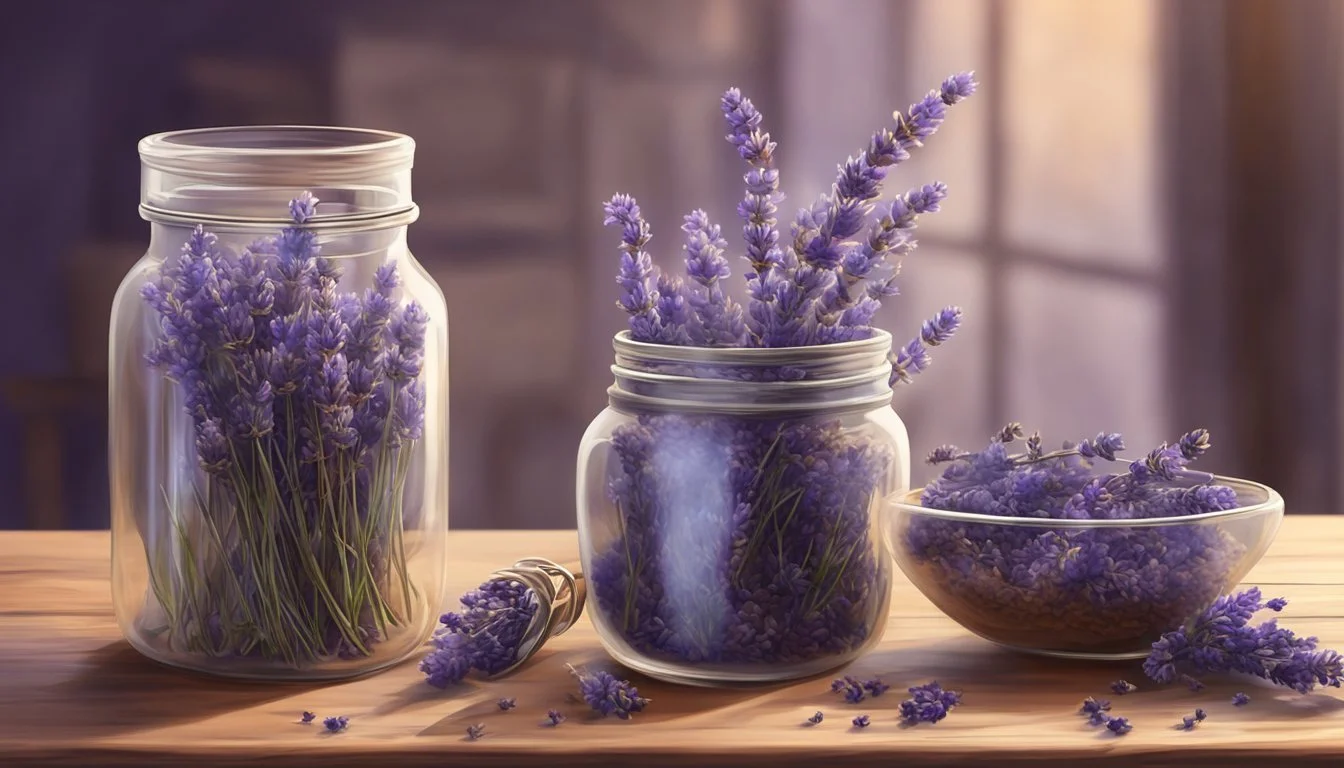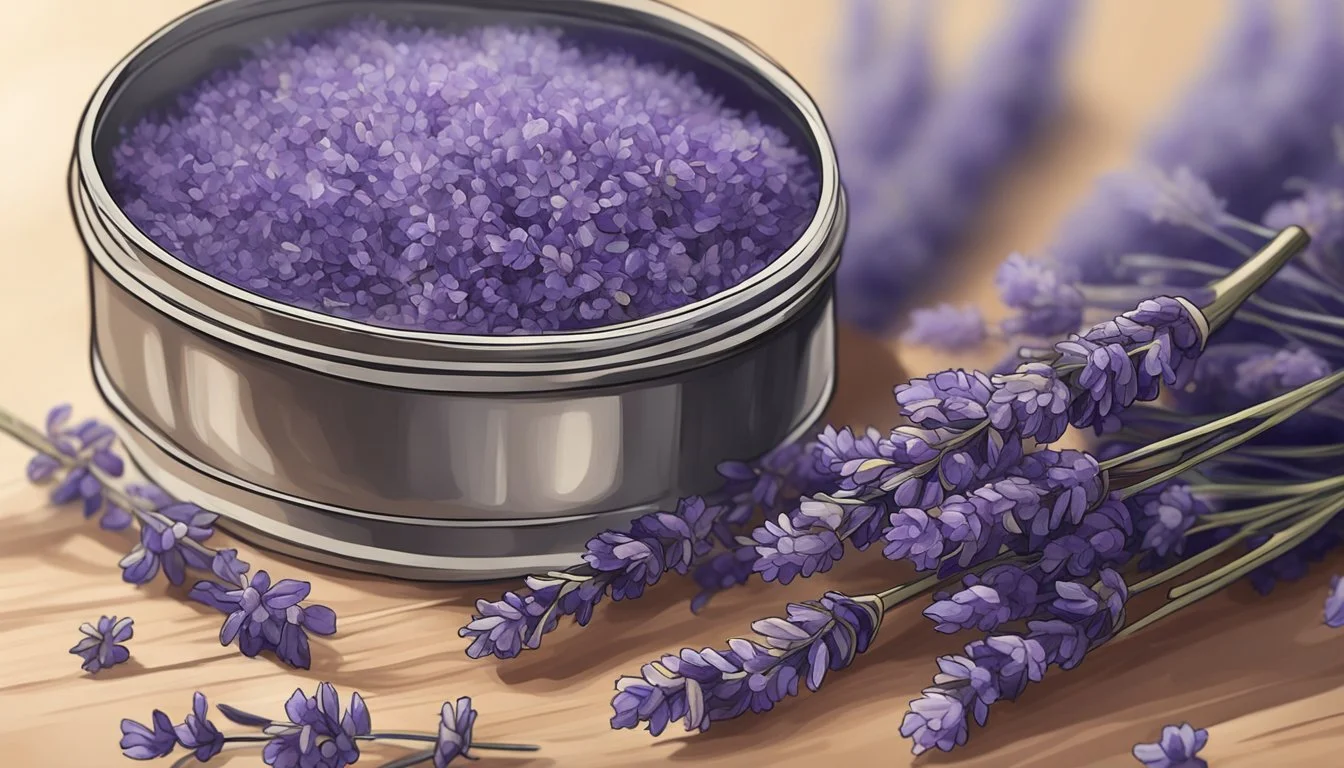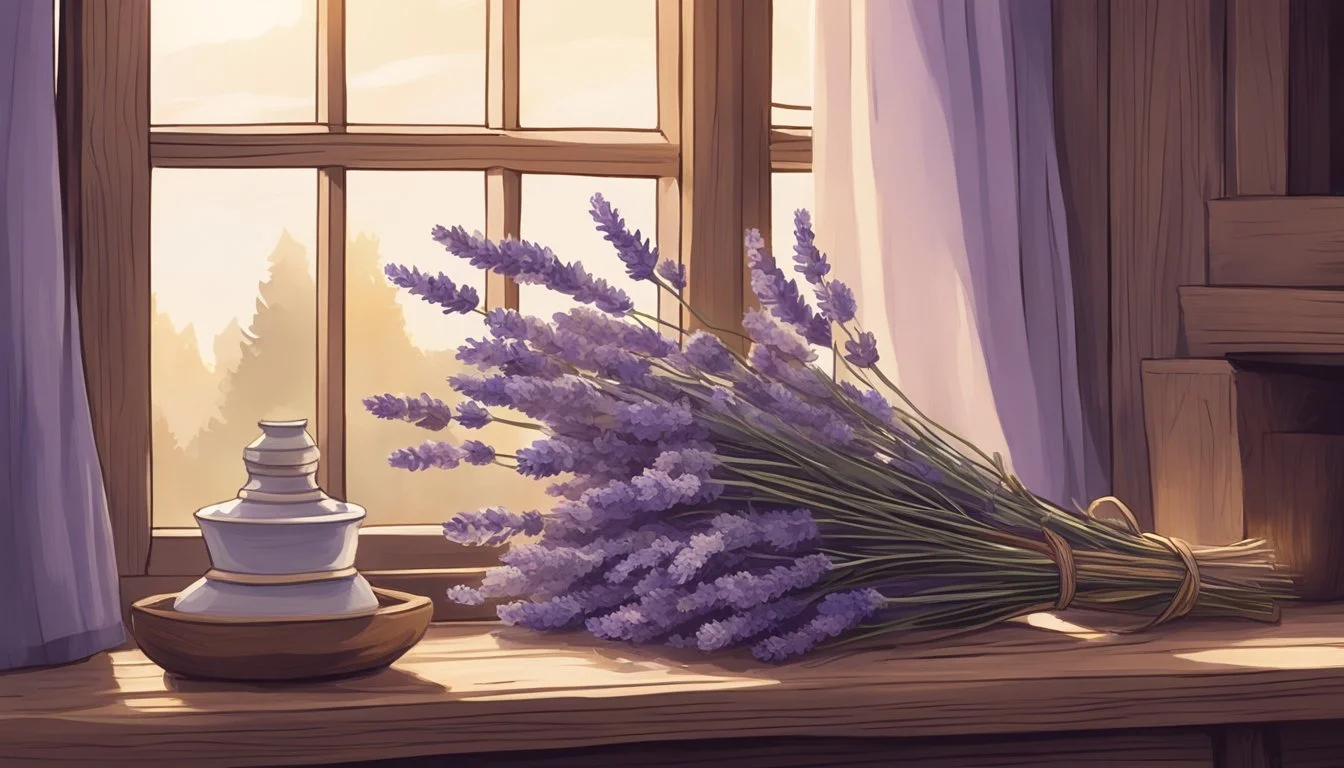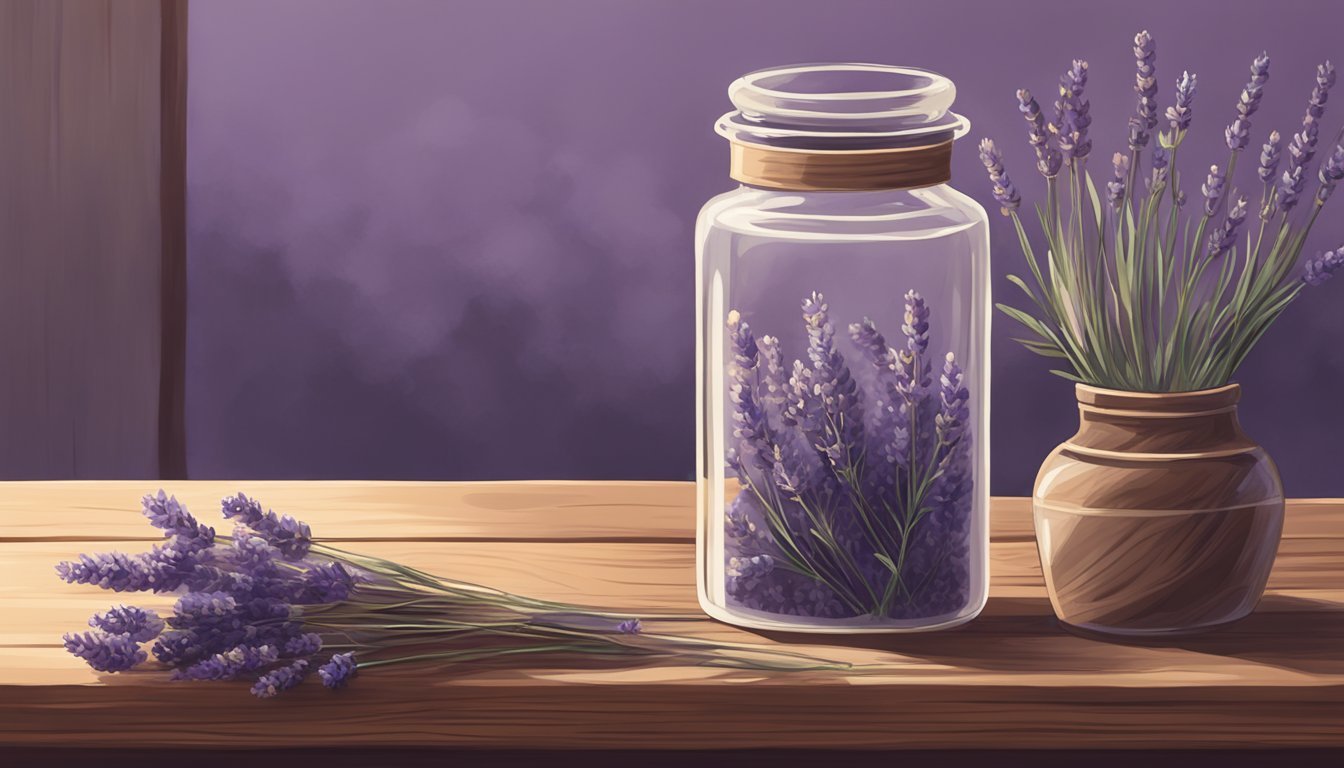How Long Does Dried Lavender Last?
Shelf Life and Preservation Tips
Dried lavender (how long does dried lavender last?) is valued for its enduring fragrance and versatility in various uses from culinary applications to home decor. The shelf life of dried lavender is impressive, often lasting up to ten years when properly stored. To ensure maximum longevity, it is essential to dry the lavender thoroughly, which typically takes two to three weeks, and then keep it away from direct sunlight in a cool, dry place.
Proper storage is crucial to maintaining the quality of dried lavender. It should be placed in airtight containers to protect it from moisture and preserve its aromatic properties. Although dried lavender can last for many years, it is recommended to use it within one to two years to experience the best quality of flavor and scent. Over time, the essential oils that give the lavender its characteristic aroma will gradually diminish, but these can be refreshed with a few drops of lavender essential oil.
It's worth noting that the condition of dried lavender can be visually and olfactorily assessed; crispness and a strong scent are indicators of good condition, while any signs of moisture, which could lead to mold, are indicators that the lavender no longer retains its original quality. Knowledge of these storage techniques and care tips ensures that dried lavender remains a long-lasting addition to anyone's pantry or craft collection.
Understanding Dried Lavender
The longevity and quality of dried lavender depend largely on the variety of lavender, the harvesting process, and the drying method used. The proper approach to each step determines how long and well the lavender will retain its aroma and appearance.
Lavender Varieties
Lavender is commonly referred to by its genus name Lavandula. The most widely cultivated species is Lavandula angustifolia, known for its potent fragrance and oil. Different varieties of lavender plants produce flowers that differ slightly in color, size, and scent intensity, which can affect drying results. For example, Lavandula x intermedia, also known as lavandin, yields a higher oil content and larger buds.
Harvesting Lavender
The optimal time to harvest lavender is when the buds are formed, but before the flowers fully open, as this maximizes oil content and scent. Harvesting should be done on a dry day, typically in late morning after the dew has evaporated. Using sharp scissors or shears, one should cut the stems, leaving a portion of the green growth on the plant to encourage regrowth.
Best Way to Dry Lavender
To dry lavender effectively, it should be tied in small bundles and hung upside down in a well-ventilated, dark, and dry room. This method allows for even drying and prevents the stems from bending, which maintains a more appealing appearance for crafting or display. Drying can take between two to four weeks, depending on the conditions. Once fully dry, the lavender can be stripped from the stems for storage or used as whole stems for decorative purposes. To best preserve its scent and prevent rot or mold, dried lavender should be stored in airtight containers away from direct sunlight.
Fundamentals of Storing Dried Lavender
Proper storage of dried lavender significantly extends its shelf life, maintaining its fragrance and quality. Adhering to specific storage methods ensures that lavender retains its properties effectively.
Selecting Storage Containers
For optimal preservation, dried lavender should be stored in airtight containers. Glass jars with tight-sealing lids are recommended as they prevent the entry of moisture while maintaining the lavender's aromatic potency. Plastic containers can be used as long as they are of food-grade quality to avoid chemical leaching.
Ideal Storage Conditions
The longevity of dried lavender correlates directly with storage conditions. The containers should be placed in a cool, dry place where there is limited exposure to environmental variables. High humidity levels can introduce moisture, leading to mold. To mitigate this, silica gel packets can be added to the containers to absorb any excess moisture.
Impact of Light and Heat on Lavender
Dried lavender should be shielded from light and heat. Exposure to direct sunlight and elevated temperatures can degrade the essential oils responsible for lavender's fragrance. Storage in a dark place, such as a pantry or cupboard, minimizes this risk. Keep away from stoves, radiators, and windows to maintain the efficacy of the dried flowers.
Maximizing Shelf Life of Dried Lavender
To ensure dried lavender maintains its quality—preserving its color, fragrance, and potency—for culinary uses like lavender tea or potpourri, it’s crucial to adhere to specific storage guidelines and understand the factors that can lead to degradation.
Proper Storage Practices
Storage Containers: Store dried lavender in airtight containers to protect it from external elements. Containers made of glass or metal are preferable, as they don’t hold scents and are less permeable to moisture than plastic can be.
Location: Keep the containers in a cool, dark place to ensure the longevity of the lavender's quality. A pantry or cupboard away from heat is ideal.
Whole Buds: Retain the buds whole, as grinding them exposes more surface area to air and can accelerate loss of aroma.
Preventing Moisture and Humidity
Humidity Control: Ensure that the area where the dried lavender is stored is low in humidity. Excess moisture can cause mold growth and decrease shelf life.
Silica Gel Packs: Consider adding silica gel packets to the storage containers to absorb any residual moisture and keep the environment dry.
Regular Checks: It’s recommended to check the lavender periodically for any signs of moisture and to ensure that its scent remains fresh.
Avoiding Oxidation and Degradation
Limited Exposure to Air: Each time the lavender is used, limit its exposure to air as much as possible. This step is vital since repeated exposure can cause oxidation, which diminishes the essential oils responsible for lavender’s aroma and color.
Refresh with Oil: To maintain the strong scent of lavender, especially when used in sachets, add a few drops of lavender essential oil to the dried flowers.
By following these specific practices, one can maintain the integrity of dried lavender for up to 10 years. However, for the best culinary experience, such as in teas or as a spice, use the herb within a year, as flavor and scent are at their peak during this period. While dried lavender can last for several years under optimal conditions, regular evaluation of its quality is suggested, as all dried herbs can eventually go bad.
Lavender Uses and Considerations
When incorporating dried lavender into various aspects of daily life, it's essential to consider how its distinct flavor and aroma can enhance culinary dishes, provide therapeutic benefits, and add creativity to crafts. Dried lavender’s versatility makes it a valuable addition to any home.
Culinary Applications
Dried lavender is known for its potent flavor and is used sparingly in cooking and baking. It lends a floral, slightly sweet taste to dishes. Key considerations in culinary use include:
Edibility: Ensure that the dried lavender used in food is labeled as "culinary grade."
Flavor Pairing: Lavender pairs well with savory dishes like roasted meats (What wine goes well with roasted meats?) or sweet desserts like cakes.
Infusions: Steeping the buds in liquid can impart flavor into teas, syrups, and sauces.
Aromatic and Therapeutic Uses
The soothing scent of dried lavender is highly sought after for its relaxing properties. Whether in the form of essential oils or the buds themselves, its applications are diverse:
Lavender Essential Oil: Often used in aromatherapy, it can be added to diffusers for a calming atmosphere.
Personal Care Products: Homemade soaps, bath salts, and lotions can be enhanced with the addition of lavender.
Debris Considerations: Ensure that dried lavender is free from dust and debris to maintain its purity, especially when used for therapeutic purposes.
Creative and Craft Usage
Dried lavender is not just functional; it’s also aesthetically pleasing and is widely used in various crafts:
Decoration: Dried sprigs and flowers make beautiful additions to wreaths, arrangements, and potpourri.
Longevity in Crafts: Dried lavender can retain its scent and resist deterioration, making it an ideal choice for long-lasting crafts.
Refresh and Reuse of Dried Lavender
Maximizing the lifespan and fragrance of dried lavender involves careful revitalization and finding innovative ways to recycle it throughout the home. By utilizing specific techniques, you can rejuvenate lavender's aroma, repurpose it for new uses, and integrate it artfully into various spaces.
Revitalizing Lavender's Aroma
To restore the scent of dried lavender, which can naturally wane over time, one may consider the gentle application of lavender essential oil. Adding a few drops of essential oil directly onto the dried lavender can significantly rejuvenate its fragrance. This method is particularly effective for lavender that has become less aromatic but is not yet brittle or moldy.
Recycling Lavender for New Uses
Transforming dried lavender for new purposes can be both an eco-friendly and creative endeavor. The leaves are well-suited for crafting homemade soaps or sachets, which can then be conveniently placed in a closet, pantry, or bathroom to impart a clean scent. Moreover, the repurposed lavender bags shield fabrics from moths while also keeping enclosed spaces smelling fresh.
Incorporating Lavender in Home Décor
Lavender's aesthetic appeal offers a dual function as a decorative element with a pleasant aroma. Arranging whole stems in a vase or creating a book of pressed lavender leaves can offer not only a visual upgrade to your home but also maintain a lingering, subtle fragrance. When incorporating lavender into décor, ensure it stays out of direct sunlight to prevent it from becoming faded or losing its scent prematurely.
By following these practices, dried lavender can retain its charm and utility, harmoniously blending form and function within the household.
Preserving Lavender for Cooking and Tea
When using lavender for culinary purposes or in herbal teas, proper storage methods are essential to maintaining its flavor and aroma.
Storage Tips for Culinary Lavender
Culinary lavender adds a delightful and aromatic flavor to various dishes and baked goods. To ensure its longevity and potency in cooking and baking, one should adhere to the following guidelines:
Keep It Cool and Dry: Store in a cool, dry area of the pantry or kitchen to prevent moisture and heat from diminishing the lavender's quality.
Airtight Containers: Transfer the dried lavender to airtight containers, which could be glass jars or resealable plastic bags, to protect it from air exposure.
Labeling: Clearly label containers with the date of storage. This practice helps in keeping track of freshness and ensures the use of lavender at its peak flavor.
Away from Sunlight: Position containers out of direct sunlight to avoid the bleaching of color and erosion of essential oils.
Brewing Lavender for Herbal Teas
Lavender tea is renowned for its calming properties and can be a blend of pure lavender or mixed with other herbs such as chamomile for additional benefits. Here are the important considerations:
Proportion: For brewing, use about one teaspoon of dry lavender buds (how long do lavender buds last?) for one cup of hot water, adjusting for personal taste preference.
Storage: Like with culinary use, store lavender for tea in airtight containers and place them in a dark, cool space to preserve the calming essence and edible quality.
By observing these specific storage practices, one ensures that lavender, whether intended for culinary uses or as a comforting tea, maintains its desirable characteristics for an enriched flavor and aromatic experience.
Special Considerations for Dried Lavender
Storing dried lavender requires attention to detail to maintain its quality and aroma. Considerations such as pest control and proper labeling are crucial for preserving lavender's potency and ensuring it remains a versatile herb for culinary, therapeutic, or aromatic uses.
Controlling Lavender Pests
Lavender is naturally an insect repellent due to its strong scent, which deters moths and other insects. However, when stored, it can still be vulnerable to infestations. To protect dried lavender:
Store in airtight glass containers to prevent pests.
Consider placing rose petals or cinnamon sticks (how long do cinnamon sticks last?) inside the storage area as additional natural repellents.
Ensure the storage location is dry with good ventilation to discourage pests.
Labeling and Organizing Lavender Storage
Correct labeling and organization are key to maintaining dried lavender’s potency and ensuring it remains edible, if intended for culinary use. When labeling:
Label each container with the contents and the date of drying.
Keep the containers in a convenient yet cool and dark place to protect from light degradation.
Use a system that’s both easy to manage and that aids in rotating stock based on age, utilizing older stock first.
By following these special considerations, one can extend the shelf life and enjoyment of dried lavender.
Additional Tips on Dried Lavender Care
Caring for dried lavender properly can significantly extend its quality and shelf life. Vigilance in storage and regular checks can prevent decay and ensure that lavender's aromatic attributes remain potent.
Checking for Mold and Decay
Regular Inspection: It's important to frequently inspect dried lavender for signs of mold and decay, especially if stored in a potentially humid environment. Signs of mold may include a musty smell or visually moldy patches on the buds or stems. Lavender should remain dry and brittle to the touch; any moisture may indicate decay.
Storage Conditions: Store dried lavender in a cool, dry place away from humidity to prevent mold growth. Containers should be airtight to keep out moisture. Silica gel packs can be added to absorb any excess humidity and safeguard the lavender's quality.
Replacing Old Lavender
Assessing Potency: Over time, even properly stored lavender can lose its scent and potency. A simple rule of thumb is to gently crush a small amount of lavender between one's fingers; if it still releases a strong aroma, it maintains good quality. If the scent is weak or absent, it may be time to replace the dried lavender.
Shelf Life Considerations: While dried lavender can last for several years, it is best used within one to two years for maximum aroma. After this point, even if there are no signs of mold or decay, the aromatic compounds have likely degraded, and the lavender may not impart the desired sensory effects.
The Lifespan of Lavender
When well-preserved, dried lavender can retain its fragrance and beneficial properties for an extended period. This section delves into the factors that influence how long dried lavender lasts and the average duration one can expect it to maintain its freshness.
Factors Affecting Lavender's Longevity
The lifespan of dried lavender is strongly influenced by the conditions it is kept in:
Sunlight: Exposure to sunlight can degrade the essential oils in lavender, diminishing its fragrance.
Humidity: High humidity levels may introduce moisture, leading to mold and a shortened lifespan.
Ventilation: Poor ventilation contributes to humidity problems, whereas good airflow promotes longevity.
Proper Storage: The way dried lavender is stored greatly impacts its quality over time. One should store it in a cool, dry place, shielded from light and in an airtight container to mitigate any potential quality degradation.
Average Duration of Lavender Freshness
Typical Freshness Span: Generally, dried lavender can remain fragrant for 1-2 years if kept under optimal conditions, with a possible extension if essential oils are replenished.
Longevity Range: Although the average is up to two years, some report that with meticulous storage, dried lavender can maintain its qualities for as long as five to ten years before its scent and flavor begin to fade significantly.
It is essential to recognize the delicate nature of dried lavender and handle it with care to preserve its delightful scent and utility for as long as possible.
Growing and Harvesting Your Own Lavender
Cultivating lavender at home provides the gardener with a multipurpose plant known for its fragrance, medicinal benefits, and culinary uses. This section will guide you through the process of cultivating lavender and detail the harvest and post-harvest care necessary to ensure longevity.
Cultivating Lavender at Home
To grow your own lavender, one must select the right variety suited to the climate. English lavender (Lavandula angustifolia) is widely regarded for its rich aroma and hardiness, making it a popular choice for many gardeners. Lavender plants thrive in full sun and require well-drained soil, preferably with a pH of 6.7 to 7.1. They are tolerant of dry, light, and gravelly soils.
Planting time: Best planted in the spring or early fall.
Spacing: Space plants about 18 to 24 inches apart.
Watering: Water deeply but infrequently, once the soil is almost dry.
Here are simple steps for establishing your lavender plants:
Start with quality seedlings or cuttings.
Choose a sunny location with good air circulation.
Prepare the soil by ensuring it is loose and mixed with gravel or sand if necessary to improve drainage.
Plant lavender at the same depth it was in its pot.
Water in new plantings and provide occasional deep watering during extremely dry periods.
Harvest and Post-Harvest Care of Lavender
The best time for harvesting lavender is when the buds have formed but the flowers have not yet fully opened. This is typically from late spring until early fall. The timing will ensure maximum oil content and fragrance from the flowers. Fresh lavender should be cut early in the day after the dew has dried.
For drying lavender:
Method: Buds and flowers can be laid out to dry on screens or in airy baskets. Alternatively, bunch the stems and hang them upside down in a dark, dry place.
Duration: Depending on the method used, it can take anywhere from one to four weeks to fully dry.
Dehydrator: A dehydrator can expedite the drying process and is particularly effective when the climate is more humid.
Here's a brief overview of the harvest process:
Use sharp shears to make clean cuts.
Harvest in bunches, not individually, for efficiency.
Immediately after cutting, place lavender in a shaded area to prevent wilting.
Post-harvest, test the dryness by checking if a stem snaps cleanly. Only then is the lavender ready to be stored away. Properly dried and stored, lavender can maintain its potency for several years.
Environmental Impact and Sustainability
The cultivation and processing of dried lavender, when managed effectively, can support environmental sustainability and minimize negative ecological impact.
Eco-Friendly Practices with Dried Lavender
The focus on sustainability in growing and drying lavender is crucial to protecting natural resources. Farmers often employ eco-friendly cultivation methods, such as integrated pest management and polyculture farming, to promote biodiversity and reduce the need for synthetic fertilizers and pesticides.
After lavender is harvested and dried, its long-term usability becomes a significant eco-friendly asset. Instead of discarding lavender after its scent fades, individuals can refresh the scent with a few drops of essential oil, effectively reusing the product and reducing waste.
One should also consider the environmental impact of packaging and transportation. Using biodegradable or recyclable materials for storing dried lavender contributes to a smaller carbon footprint. By purchasing from local growers, consumers can minimize the environmental costs associated with long-distance transportation.
The practice of rehydrating or composting dried lavender after its aromatic life can positively contribute to the cycle of sustainability. This practice reduces landfill waste and supports a commitment to environment-friendly actions.
Frequently Asked Questions
This section addresses specific inquiries regarding the longevity and proper storage of dried lavender, as well as options to refresh it and its various applications.
Common Queries About Dried Lavender
How long does dried lavender last?
Dried lavender typically retains its quality for 1-3 years if stored properly.
What is the best method of storing lavender to maximize its shelf life?
Lavender should be kept in a cool, dark, and dry place. It is best preserved in airtight containers to avoid moisture and loss of scent.
Can the scent of dried lavender be refreshed once it starts to fade?
Yes, adding a few drops of lavender essential oil can renew the fragrance of dried lavender.
What are common uses for dried lavender?
Dried lavender is used for aromatherapy, culinary purposes, and as a natural repellent for insects, among other applications.
Conclusion
Dried lavender, when properly stored, has the potential to last from a full season to about ten years. The key to longevity lies in its storage conditions. Lavender should be kept in a cool, dry place away from direct sunlight. Airtight containers are recommended to preserve the scent and prevent moisture from spoiling the herb.
Storage Location: Cool, dry, and dark area
Container: Airtight
Lifespan Range: 1–10 years, depending on storage and lavender quality
Adding a few drops of lavender essential oil can rejuvenate the fragrance and extend the usefulness of dried lavender. For culinary or therapeutic use, it's best utilized within one year for maximum flavor and aroma.
Signs of Degradation: If the lavender loses its color or scent, or if there is any sign of moisture and mold, then it is no longer suitable for use.
Proper storage not only helps retain lavender's qualities but also maximizes its applications, from aromatherapy to cooking. Therefore, storing dried lavender correctly is crucial to maintain its benefits for as long as possible.










